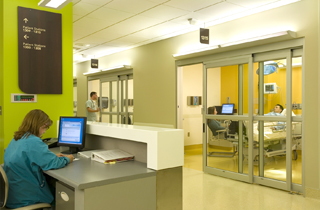|
Subscribe / Renew |
|
|
Contact Us |
|
| ► Subscribe to our Free Weekly Newsletter | |
| home | Welcome, sign in or click here to subscribe. | login |
Construction
| |
 |
June 24, 2010
Hospital noise rules get an update
Sparling

Jurdy
|
Many strides have been taken in recent years to reduce noise and vibration experienced by patients in health care facilities. Much work has been done to ensure that hospital acoustics is a vital part of the patient rest and recovery process.
The Facility Guidelines Institute (FGI) maintains guidelines that include standards for noise and vibration control. The state of Washington has helped build momentum for their use by adopting the FGI health care guidelines as standards in 2007.
The newest edition of the guidelines, released this year, includes the most comprehensive set of acoustic and vibration design guidelines for health care facilities to date.
Its predecessors, the 2001 and 2006 editions, included a small table that only addressed the acoustical separation between spaces. The latest edition now includes comprehensive criteria for noise, privacy, acoustics and vibration.

The state Department of Health has started to review plans to ensure compliance with the acoustics and vibration guidelines. The new acoustical criteria have already been adopted and piloted by the Green Guide for Health Care, the health care sector’s first quantifiable sustainable design toolkit, and accepted by LEED for Health Care as the reference standard for two new environmental quality acoustical credits.
The 2010 guidelines address six areas that relate to acoustics:
Exterior noise
Exterior noise is generated by mechanical equipment located on the roof or within a central utility plant.
The guidelines here differ from codes already established by local jurisdictions. If the site is inherently noisy due to a nearby freeway, railroad or airport, the design of the building facade should take into account acoustical performance of the windows.
Site noise can be estimated by using the site noise classification presented in the guidelines or by conducting actual site noise measurements. If the site is noisy, the acoustical requirements for the building facade should be accounted for in the cost model early in the design.
Acoustic finishes
Normal hospital noises come from a variety sources such as voices, nurse stations, public areas and rolling carts in corridors. Acoustic finishes help reduce overall noise within an occupied space and, to some extent, reduce noise transmission between spaces through open doors.
Nurse stations with sound-reflective surfaces are noisier than nurse stations with sound-absorptive surfaces. Voices heard in a patient’s room through an open door facing a nurse station are louder with hard surfaces than with absorptive surfaces.
Specific goals are identified for the average sound-absorption coefficients for different occupied spaces. Proof of compliance might require calculation sheets for the different types of rooms.
Room noise
Room noise refers to the mechanical equipment noise received within occupied spaces. Worth noting are the criteria for neonatal intensive care unit rooms. Here, too, compliance might require sample calculation sheets.
Interior construction
Sound Transmission Class is a numerical rating used for gauging the ability of a partition to reduce noise. It can be used to rank and compare doors, windows, enclosures, noise barriers and partitions.
The rating (for example: STC 35, STC 40, STC 45) is expressed in terms of the products’ relative abilities to provide privacy against intrusion of speech sounds. The higher the rating, the more effective it is.
Some STC requirements have been relaxed from the 2006 edition of the FGI, most notably for patient room partitions with entrances.
The 2006 edition required an STC 45, but the 2010 edition requires only an STC 35. The STC 45 requirement is a financial hardship for hospitals and hasn’t been proven a benefit to patients. The 2010 edition’s STC 35 requirement, though much less stringent than its predecessor, is still a challenge to meet because of the competing functions at this partition.
With patient room partitions, entrances are often designed with pass-throughs and sliding doors. Pass-throughs are intended to reduce staff fatigue and walk-ins on patients, and glass sliding doors are intended to maximize the space efficiency.
Equipping sliding doors with full seals is possible but does not guarantee acoustical performance. The challenge is associated with the bottom seal, which requires a floor track. This track might conflict with cleanliness requirements. The absence of the bottom seal affords a partition with acoustical performance closer to STC30 than STC35.
Traditionally, patients desire to keep their doors open. Thus, their rooms become acoustically coupled with the corridor, and the acoustical rating of the partition loses its effectiveness. Sliding the door closed provides 25 to 30 decibels of noise reduction over an open door. That is approximately 80 percent to 88 percent of noise reduction. The intent of the code is to reduce the overall noise in the hospital for the benefit of the patients and staff.
Speech privacy
In 1996, the Health Information Portability and Accountability Act elevated the importance of providing reasonable safeguards to protect the confidentiality of patient information, which included privacy of orally communicated information.
FGI guidelines now identify speech privacy goals using one of four speech rating methods. These goals are identified as “normal” or “confidential.” They apply to areas of the hospital where private conversation with or about a patient are not to be overheard. It is important that these areas be identified early in the design process to help ensure that the privacy goals are met.
Building vibration
FGI guidelines set a vibration limit in the building structure for patient rooms and areas due to human footfalls.
This maximum limit is set at a vibration velocity of 4,000 microinches per second. Traditionally, this not-to-exceed limit was used for general-use operating rooms. Under the 2010 FGI, this limit was extended to cover patient rooms and areas as well.
The floor structure for the patient areas should be evaluated early in the design to ensure compliance with this requirement. The FGI identifies the American Institute of Steel Construction’s “Design Guide 11: Floor Vibration Due to Human Activities” as the basis for this evaluation.
As we enter this new era for acoustic designs in health care facilities, a reference standard, “Sound & Vibration 2.0,” was put together to be used alongside the 2010 FGI guidelines. This reference standard provides detailed information, constructive advice for designers and engineers, reference tables, charts and graphs. “Sound & Vibration 2.0” has already been adopted as the sole reference standard for two LEED environmental quality credits in the Green Guide for Healthcare and LEED for Healthcare, which is in draft.
Basel Jurdy is a principal at Sparling, an electrical, technology, acoustical and lighting firm headquartered in Seattle. He has more than 20 years of developing acoustical design in the built environment.
Other Stories:
- Mental health clinic breaking ground in Burien
- Hospitals: get ready for climate change laws
- Federal program keeps money flowing for hospital projects
- MultiCare opens $117M Tacoma campus expansion
- Surgical advances create ‘hybrid’ operating rooms
- Robots bring changes to operating room design
- In wake of reform, hospitals try doing more with less


